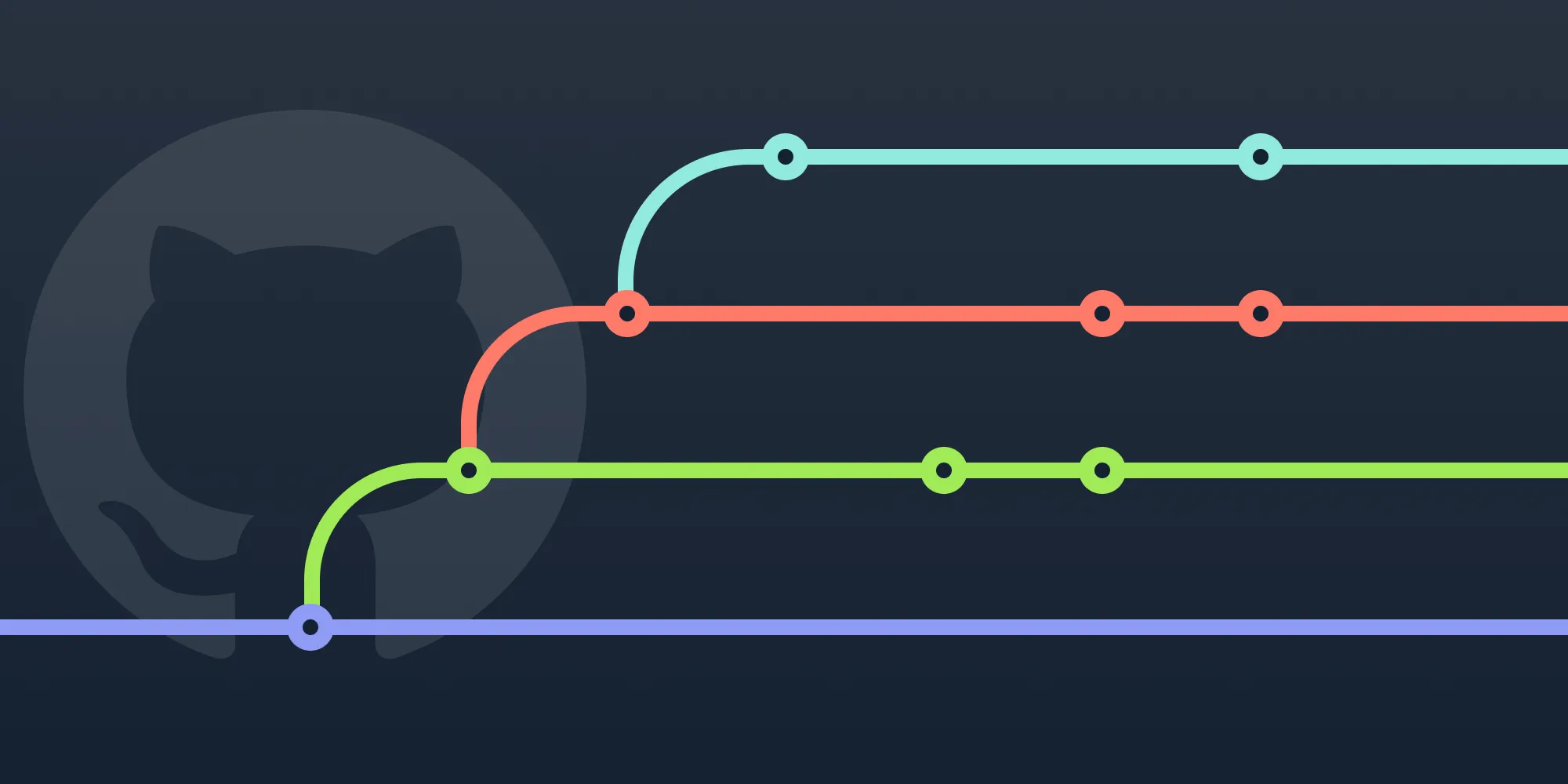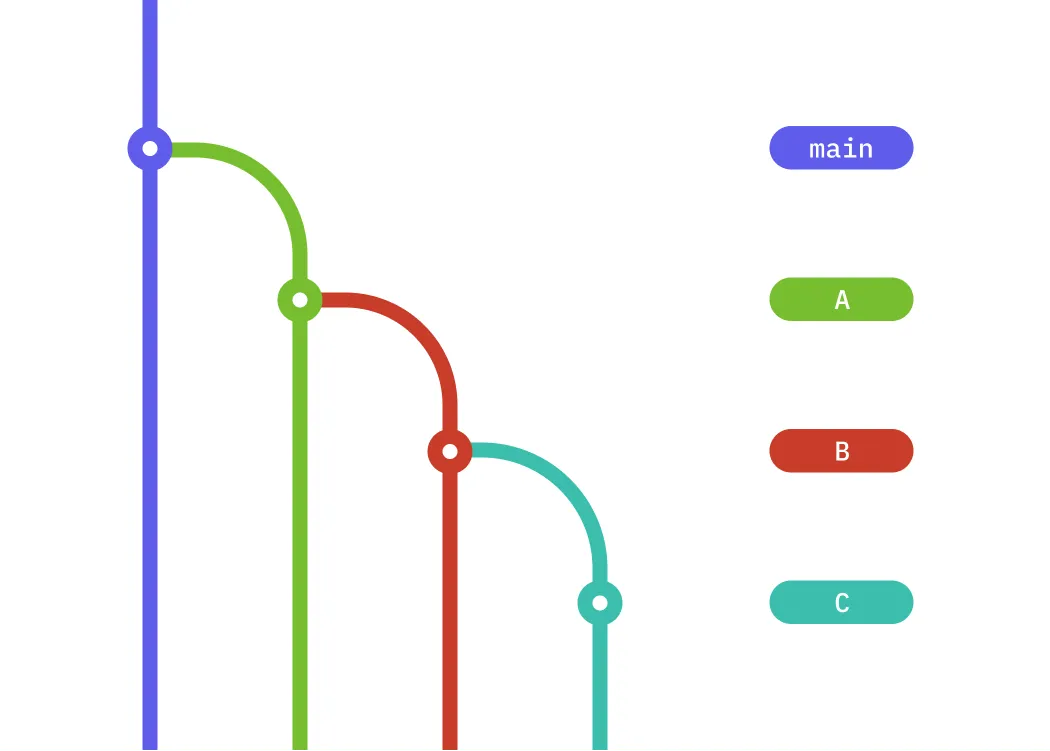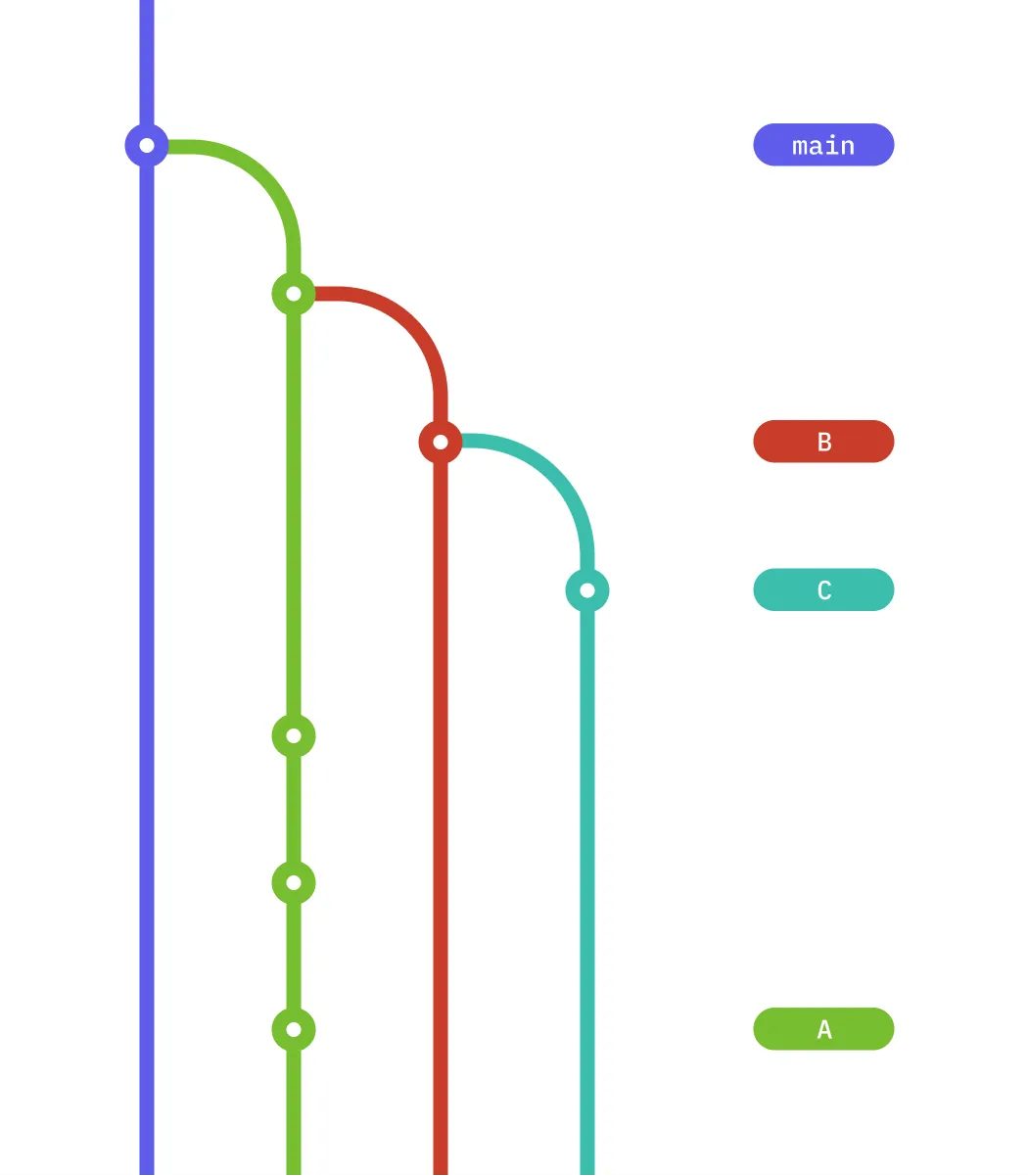How to handle stacked PRs on GitHub
Table of contents

If you develop software, there’s a good chance you use a platform like GitHub to collaborate and work together on code with your team. The basic unit of reviewable code in GitHub is the pull request, but the implementation of a feature may require several pull requests. This blog post will give you the necessary git and GitHub concepts to understand how to work with dependent (stacked) pull requests.
What are stacked pull requests?
GitHub is designed in a way that all reviewable code must be part of a git branch. The typical workflow when you want some changes to be reviewed is that you:
- First, create a local git branch.
- Next, push the branch to the remote repository you share with your colleagues.
- Then, create a pull request — a process in which you need to select your new branch and a base branch (where you want your changes merged), which is typically (but not always, as you’ll see) the main development branch.
But what happens when you need to create several pull requests to complete the implementation of a given feature? In this case, you’d create, say, three pull requests: A, B, and C. Pull request A will merge into the main development branch; pull request B will build on top of A and merge into A; pull request C will build on top of B and merge into B.

This situation is what’s usually called a stack of pull requests. The diagram above represents the scenario visually. Feature branches can be organized in a stacked manner to manage and coordinate changes effectively, allowing teams to work concurrently on multiple aspects of a larger feature.
Understanding the stacking workflow
The stacking workflow is a development strategy that involves creating a series of small, manageable pull requests that build upon each other. This approach allows teams to break down large features into smaller, more focused changes, making it easier to review and test each component individually. The stacking workflow is particularly useful in larger projects where a single pull request could become overwhelming to review.
In a stacked workflow, each pull request is created on top of the previous one, forming a chain of dependent changes. This allows developers to work on multiple features simultaneously, without having to wait for previous changes to be merged. The stacking workflow also enables teams to prioritize and manage their work more effectively by focusing on smaller, more manageable tasks.
How does GitHub compute the contents of a pull request?
As mentioned earlier, when you create a pull request, you need to specify two parameters: the branch with the work you want to integrate, and the branch you want the work to be integrated into (the base branch). With that information, GitHub is able to check if the work is actually mergeable (that is, if there are no conflicting changes in both lines of work), and if so, produce a diff(opens in a new tab) of the changes that can be reviewed by a person.
In a pull request, GitHub calculates the diff between the branch and the base branch using the triple-dot notation(opens in a new tab) of the git diff command. This notation lets you view the changes in a branch, starting at the common ancestor of both branches. For example, if you open a pull request for a branch named my-awesome-feature against main, GitHub will internally perform the following diff:
git diff main...my-awesome-featureThe output of this command will show the contents of my-awesome-feature, starting at the common ancestor between main and my-awesome-feature.
What is the common ancestor of two branches?
You may ask what the common ancestor of two git branches is. In general, there may be more than one, but in many cases, you’ll only be interested in the closest one. This is also known as the merge base; this is a concept from graph theory(opens in a new tab) that applies to git as well.
For example, consider the following topology of the main and my-awesome-branch branches.

The merge base between main and my-awesome-branch is the commit fork-point. This is the commit my-awesome-branch was branched from.
A common stacked pull request workflow on GitHub
Now that you know how GitHub prepares a pull request’s page to review code, it’s time to see how a workflow with several stacked pull requests may work.
Suppose you have the following set of stacked branches, which is the same example you saw in the What Are Stacked Pull Requests? section.

The corresponding pull requests would be A, whose base branch is main; B, whose base branch is A; and C, whose base branch is B. In this initial configuration, everything works fine, each pull request is mergeable, and reviewers will only see the changes introduced by the corresponding pull request. Everyone is happy.
It’s important to clearly indicate the hierarchy of these requests to avoid confusion during this process.
Complexity starts as soon as the branches evolve — for example, because new commits are added (such as in response to review comments), or because some of the pull requests are merged (or squash merged into a single commit). The next sections will analyze the different situations in more detail.
When some commits are added to pull request A
Below, you’ll see a graphical description of the scenario after you commit three changes to A.

If you add commits to pull request A, those changes may conflict with the changes in pull request B. If that happens, you won’t be able to merge pull request B cleanly into A (or into main, when A is merged into main).
There are many possible solutions to this problem. For example, a popular one would be to perform a git operation known as git rebase so that the B branch appears to have branched from the top of branch A. (You’ll need to fix conflicts manually so that the branch is mergeable again.)
Typically, git rebase is run as follows:
git rebase <upstream>In this sample scenario, if you’re in branch B, you could write the following:
git rebase AIn that case, git rebase will do the following:
- Calculate the commits in
Bthat aren’t inAand save them in memory, temporarily. - Check out the
Abranch. - Reapply the saved commits on top of
A(after you resolve the merge conflicts).
You can understand the git rebase command as a “cut and paste” command, where the commits in the B branch are “cut” and then “pasted” on top of the A branch. This analogy isn’t totally correct, though: The pasted commits aren’t the same as the ones you cut; they’re different ones but with identical changes. And if you resolved conflicts along the way, the contents won’t be the same. I know, it’s confusing!
Breaking down large features into smaller PRs can facilitate quicker reviews, reduce the likelihood of bugs, and make collaboration more efficient.
When pull request A is merged and closed
If you finish addressing feedback on pull request A and you merge and close it, the following things would happen to the dependent pull requests, B and C:
- As soon as you merge and delete the
Abranch, the base branch of theBpull request — which wasAoriginally — will switch tomain. - GitHub will update the diff view of pull request
Bby issuing the command explained in the How Does GitHub Compute the Contents of a Pull Request? section:
git diff main...BRemember that this command shows the contents of B, starting at the common ancestor between main and B. In other words, this is equivalent to git diff $(git merge-base main B) B. The problem is that the common ancestor of both branches is the commit where the A branch started diverging from main.
Two things may happen: In the best case, you’ll see a huge diff that contains the changes from A (already merged), and in the worst case, the pull request won’t be mergeable.
The solution to this apparent mess is to keep the calm and think about what the GitHub web interface expects. The base branch of the B pull request is now main, so you’d like to make B as if it branched from main. git-rebase to the rescue again!
From branch B, issue this command:
git rebase mainIn this case, the commits from B that aren’t already on main will be reapplied. This seems easy, but in practice, the way git rebase checks if a commit is already in the destination branch may introduce duplicated commits. The following section explains the problem in more detail.
Rebasing branches in a stacked pull request may cause duplicated commits
How does git rebase know if a commit is already on main? It compares the contents of the commit, so even if both commits have different hashes but the same contents, git rebase will skip it. However, if you fixed conflicts, the contents of both commits won’t be exactly the same, so git rebase will create duplicated commits that will cause further conflicts if you need to rebase the branches again.
One solution to avoid this messy situation is to pass an option to the git rebase command to actually “transplant” one branch onto another, giving more flexibility about which commits you want to rebase: git rebase --onto is the option to do that.
Using git rebase --onto as a more flexible way to rebase
The syntax of git rebase with the --onto option is the following:
git rebase --onto <newbase> <upstream>In the example of the main and B branches, if the current branch is B, the command would be:
git rebase --onto main AThis will only “transplant” the commits between A and B (that is, the output of the git log A..B command).
Once you’ve rebased the subset A..B onto main, you can git push --force-with-lease your changes. The pull request’s webpage should only contain the changes in B that aren’t in main, and the pull request should be mergeable again.
You’ll need to follow the same process for the other dependent branches, such as C in the example above.
Managing stacked pull requests
Managing stacked pull requests requires careful planning and coordination. Here are some best practices to help you manage stacked pull requests effectively:
- Clearly communicate the stacking order — Make sure to clearly state that a pull request is stacked on top of another, and provide a clear description of the changes made in each pull request.
- Use descriptive names — Use descriptive names for each pull request to help reviewers understand the context and purpose of each change.
- Keep pull requests small — Keep each pull request small and focused, to make it easier to review and test each component individually.
- Use automation tools — Use automation tools, such as GitHub Actions or GitLab CI/CD, to streamline the review and testing process.
By following these best practices, you can ensure your stacked pull requests are well-organized and easy to manage, making the development process smoother and more efficient.
Code review with stacked pull requests
Code review is an essential part of the development process, and stacked pull requests can make it easier to review and test each component individually. Here are some benefits of code review with stacked pull requests:
- Easier to review — Stacked pull requests make it easier to review each component individually, without having to sift through a large amount of code.
- Faster review — Stacked pull requests can speed up the review process by allowing reviewers to focus on smaller, more manageable changes.
- Improved quality — Stacked pull requests can improve the quality of the code by allowing reviewers to catch errors and bugs earlier in the development process.
By leveraging the advantages of stacked pull requests, teams can enhance their code review process, leading to higher quality code and more efficient development cycles.
Conclusion
Good code review practices encourage sending small chunks of code to review. For efficiency, developers working on a non-trivial feature build a pipeline of dependent changes, where some parts of the code are being reviewed and addressed while other parts are being developed further. If you use GitHub as your code review platform, this means implementing a workflow commonly known as stacked pull requests.
As of now, working with stacked pull requests on GitHub isn’t as easy as it could be, and it requires some knowledge about how git works. We hope this article helped shed some light on the git concepts you need to master to feel confident dealing with stacked pull requests and to develop your own automation to make the process simpler.
FAQ
What are stacked pull requests?
Stacked pull requests are multiple PRs created in sequence, where each PR depends on the changes in the previous one.
Why should I use stacked pull requests?
They make large changes easier to review by breaking them down into smaller, manageable parts.
How does git rebase help with stacked pull requests?
git rebase allows you to reorder or reapply commits, keeping PRs aligned when changes are added or merged in a stack.
What should I do if I encounter conflicts between stacked PRs?
Use git rebase to align dependent branches, and resolve conflicts manually to ensure each PR merges smoothly.
Can stacked pull requests be merged out of order?
No, each stacked PR must be reviewed and merged sequentially to maintain the dependency chain.







